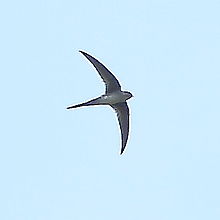Neotropical palm swift
| Neotropical palm swift | |
|---|---|

| |

| |
| Fork-tailed palm-swift flying over Apiacás, Mato Grosso state, Brazil | |
| Scientific classification | |
| Kingdom: | Animalia |
| Phylum: | Chordata |
| Class: | Aves |
| Order: | Apodiformes |
| Family: | Apodidae |
| Genus: | Tachornis |
| Species: | T. squamata
|
| Binomial name | |
| Tachornis squamata (Cassin, 1853)
| |

| |

The Neotropical palm swift or fork-tailed palm swift (Tachornis squamata) is a swift native to tropical South America (from Colombia, Venezuela, the Guianas south to northeastern Peru and Brazil) and Trinidad in the Caribbean.
Habitat and breeding[]
This small bird is found locally in marshy habitats, or sometimes open forest, usually near Moriche Palms. It builds a C-shaped nest of feathers, saliva and plant material on the inside of the dead leaf of a Moriche Palm. Three white eggs are laid in the depression of the C, and incubated for 21 days to hatching.
Description[]
The neotropical palm swift is a slender, narrow-winged species, 13.2 cm long, with a long forked tail, and weighs 11 g. The call is a buzzed djjjjjj, like an insect. The nominate western form T. s. squamata has black-brown upperparts with a slight greenish gloss. The underparts are a paler brown with a white throat and central underbody. The eastern race T. s. semota of Trinidad, the Guianas and central and eastern Brazil is much darker, almost steel-black above and darker brown below. Juveniles are very similar, but have buff fringes to the upperparts and head in fresh plumage.
Taxonomy[]
Despite its shape and association with palms, it is in a different genus to the Asian and African palm swifts.
Diet[]
It feeds in low flight on flying insects. It normally stays at less than 10 m above the ground. It normally occurs in small groups of up to 30 birds.
References[]
- ^ BirdLife International (2016). "Tachornis squamata". IUCN Red List of Threatened Species. 2016: e.T22686751A93125297. doi:10.2305/IUCN.UK.2016-3.RLTS.T22686751A93125297.en. Retrieved 12 November 2021.
- Swifts by Chantler and Driessens, ISBN 1-873403-83-6
- Hilty, Steven L (2003). Birds of Venezuela. London: Christopher Helm. ISBN 0-7136-6418-5.
- ffrench, Richard (1991). A Guide to the Birds of Trinidad and Tobago (2nd ed.). Comstock Publishing. ISBN 0-8014-9792-2.
External links[]
- Fork-tailed palm swift photo gallery VIREO
- Photo-High Res; Article flickr.com
- IUCN Red List least concern species
- Tachornis
- Birds of the Amazon Basin
- Birds of the Guianas
- Birds of the Caribbean
- Birds of Trinidad and Tobago
- Birds described in 1853
- Birds of Brazil
- Taxa named by John Cassin
